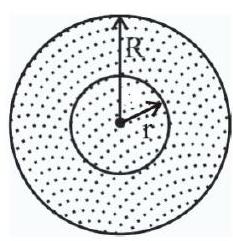138475 The density of a solid sphere of radius $R$ is $\rho(r)=20 \frac{r^{2}}{R^{2}}$ where, $r$ is the distance from its centre. If the gravitational field due to this sphere at a distance $4 R$ from its centre is $E$ and $G$ is the gravitational constant, then the ratio of $\frac{E}{G R}$ is
138476 From the pole of the earth, a body of mass $m$ is imparted a velocity $v_{0}$ directed vertically up. If $M$ is the mass of the earth, $R$ its radius and $g$ is the free-fall acceleration on its surface, then the height $h$ to which the body will ascent is (neglect air resistance)
138477 The mass density inside a solid sphere of radius $r$ varies as $\rho(r)=\rho_{0}\left(\frac{r}{R}\right)^{\beta}$, where $\rho_{0}$ and $\beta$ are constants and $\mathbf{r}$ is the distance from the centre. Let $E_{1}$ and $E_{2}$ be gravitational fields due to sphere at distance $\frac{R}{2}$ and $2 R$ from the centre of sphere. If $\frac{E_{2}}{E_{1}}=4$, the value of $\beta$ is
138475 The density of a solid sphere of radius $R$ is $\rho(r)=20 \frac{r^{2}}{R^{2}}$ where, $r$ is the distance from its centre. If the gravitational field due to this sphere at a distance $4 R$ from its centre is $E$ and $G$ is the gravitational constant, then the ratio of $\frac{E}{G R}$ is
138476 From the pole of the earth, a body of mass $m$ is imparted a velocity $v_{0}$ directed vertically up. If $M$ is the mass of the earth, $R$ its radius and $g$ is the free-fall acceleration on its surface, then the height $h$ to which the body will ascent is (neglect air resistance)
138477 The mass density inside a solid sphere of radius $r$ varies as $\rho(r)=\rho_{0}\left(\frac{r}{R}\right)^{\beta}$, where $\rho_{0}$ and $\beta$ are constants and $\mathbf{r}$ is the distance from the centre. Let $E_{1}$ and $E_{2}$ be gravitational fields due to sphere at distance $\frac{R}{2}$ and $2 R$ from the centre of sphere. If $\frac{E_{2}}{E_{1}}=4$, the value of $\beta$ is
138475 The density of a solid sphere of radius $R$ is $\rho(r)=20 \frac{r^{2}}{R^{2}}$ where, $r$ is the distance from its centre. If the gravitational field due to this sphere at a distance $4 R$ from its centre is $E$ and $G$ is the gravitational constant, then the ratio of $\frac{E}{G R}$ is
138476 From the pole of the earth, a body of mass $m$ is imparted a velocity $v_{0}$ directed vertically up. If $M$ is the mass of the earth, $R$ its radius and $g$ is the free-fall acceleration on its surface, then the height $h$ to which the body will ascent is (neglect air resistance)
138477 The mass density inside a solid sphere of radius $r$ varies as $\rho(r)=\rho_{0}\left(\frac{r}{R}\right)^{\beta}$, where $\rho_{0}$ and $\beta$ are constants and $\mathbf{r}$ is the distance from the centre. Let $E_{1}$ and $E_{2}$ be gravitational fields due to sphere at distance $\frac{R}{2}$ and $2 R$ from the centre of sphere. If $\frac{E_{2}}{E_{1}}=4$, the value of $\beta$ is
138475 The density of a solid sphere of radius $R$ is $\rho(r)=20 \frac{r^{2}}{R^{2}}$ where, $r$ is the distance from its centre. If the gravitational field due to this sphere at a distance $4 R$ from its centre is $E$ and $G$ is the gravitational constant, then the ratio of $\frac{E}{G R}$ is
138476 From the pole of the earth, a body of mass $m$ is imparted a velocity $v_{0}$ directed vertically up. If $M$ is the mass of the earth, $R$ its radius and $g$ is the free-fall acceleration on its surface, then the height $h$ to which the body will ascent is (neglect air resistance)
138477 The mass density inside a solid sphere of radius $r$ varies as $\rho(r)=\rho_{0}\left(\frac{r}{R}\right)^{\beta}$, where $\rho_{0}$ and $\beta$ are constants and $\mathbf{r}$ is the distance from the centre. Let $E_{1}$ and $E_{2}$ be gravitational fields due to sphere at distance $\frac{R}{2}$ and $2 R$ from the centre of sphere. If $\frac{E_{2}}{E_{1}}=4$, the value of $\beta$ is
138475 The density of a solid sphere of radius $R$ is $\rho(r)=20 \frac{r^{2}}{R^{2}}$ where, $r$ is the distance from its centre. If the gravitational field due to this sphere at a distance $4 R$ from its centre is $E$ and $G$ is the gravitational constant, then the ratio of $\frac{E}{G R}$ is
138476 From the pole of the earth, a body of mass $m$ is imparted a velocity $v_{0}$ directed vertically up. If $M$ is the mass of the earth, $R$ its radius and $g$ is the free-fall acceleration on its surface, then the height $h$ to which the body will ascent is (neglect air resistance)
138477 The mass density inside a solid sphere of radius $r$ varies as $\rho(r)=\rho_{0}\left(\frac{r}{R}\right)^{\beta}$, where $\rho_{0}$ and $\beta$ are constants and $\mathbf{r}$ is the distance from the centre. Let $E_{1}$ and $E_{2}$ be gravitational fields due to sphere at distance $\frac{R}{2}$ and $2 R$ from the centre of sphere. If $\frac{E_{2}}{E_{1}}=4$, the value of $\beta$ is

